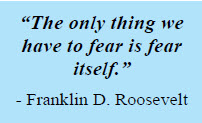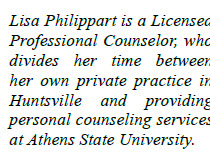The Fears We Share
 By: Lisa Philippart
By: Lisa Philippart
I know you have heard this quote from Franklin D. Roosevelt before, and for the most part, I agree with him. Being afraid of fear probably causes more problems in our lives than fear itself. I actually think that some forms of fear are not as bad as we make them out to be. Plus, I don’t think the concept of fear is all that complicated. The simplest and most understandable definition of fear is: an anxious feeling, caused by the anticipation of some imagined event or experience. In fact, doctors will tell you that the anxious feeling we get when we are afraid is a consistent biological reaction. What this means is that our body reacts the same way whether we are afraid of getting bitten by a snake, getting turned down for a job, or getting audited. I submit to you that fear, like other emotions, has a purpose in providing us with information. Fear offers us knowledge and understanding, if we accept and allow it.

There are five basic fears out of which almost all of our other fears are founded. The “Feararchy” (hierarchy of fear) was created by Dr. Karl Albrecht, a German entrepreneur who with his brother, Theo, founded the supermarket chain Aldi. These levels of fear include Extinction, Mutilation, Loss of Autonomy, Separation, and Ego-Death. In this order, they form a hierarchy of fear or “feararchy.” Let’s take a look at each:

Level One – Extinction: the fear of ceasing to exist. Put simply, the fear of death. Extinction forms the base of the hierarchy. Every one of us has at some point felt that primal existential anxiety of no longer being on this earth. (For many of us, we turn to our faith as our foundational support to guide us toward understanding our purpose when that day of death arrives.) A common daily example of fear of extinction is the fear of heights…that panicky feeling you get when you look over the edge of a tall building.
Level Two – Mutilation: the fear of losing or seriously harming any part of our bodies. We all fear the thought of having our body’s boundaries attacked, or of losing the function of any organ or body part. The fear of certain animals such as bugs, spiders, snakes, and other creepy critters is an example of the fear of mutilation.
Level Three – Loss of Autonomy: the fear of being paralyzed, restricted, overwhelmed, or smothered. In other words, this is the fear of being controlled by circumstances beyond our control. Being imprisoned is an example of loss of social autonomy. In the physical sense, it is called claustrophobia. In relationships, fear of intimacy or fear of commitment is basically fear of losing autonomy.

Level Four – Separation: the fear of neglect, rejection, or feeling disconnected. This is the fear of becoming a non-person — having no value or being unwanted or disrespected. Stripped to its most basic level, jealousy is the fear of being devalued. If you have been reading my previous articles on shame and guilt, these feelings express the fear of separation through potential isolation.
Level Five – Ego-Death: at the top of the pyramid/hierarchy. Ego-death is the fear of humiliation or profound self-disapproval, leading to the loss of the integrity of self. Taken to the extreme, ego-death is the fear of destroying one’s sense of worth, capabilities, and lovability. This is our fear of failure. The terror many people have at the idea of having to speak in public is basically fear of ego-death.
Next time we will look at ways to manage and possibly conquer your fears.
By: Lisa Philippart
Licensed Professional Counselor